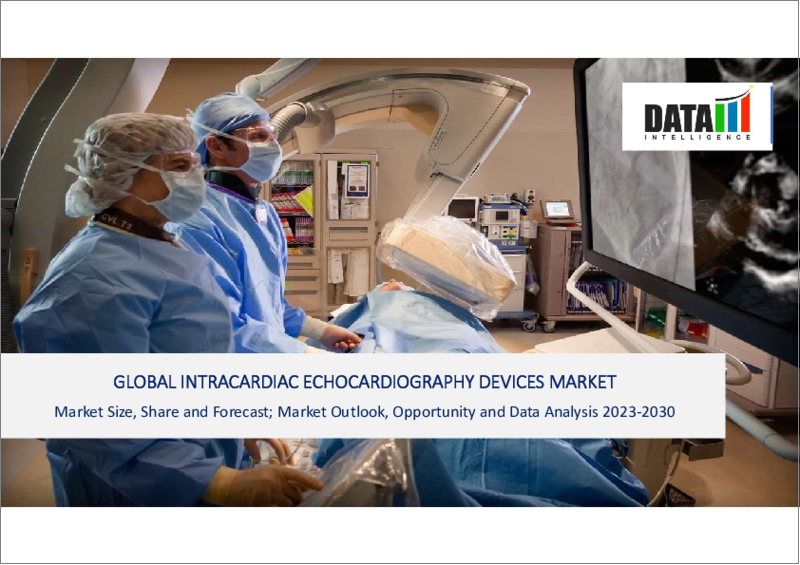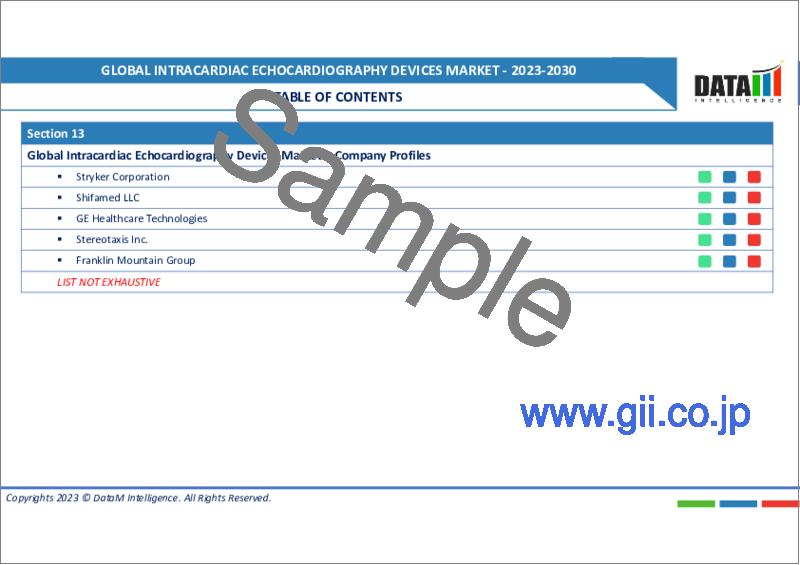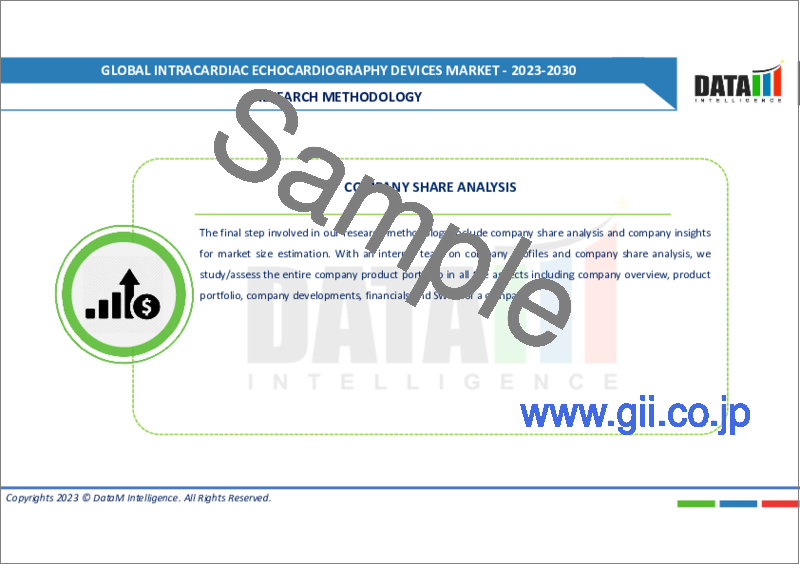|
|
市場調査レポート
商品コード
1352140
心腔内エコー装置の世界市場-2023年~2030年Global Intracardiac Echocardiography Devices Market - 2023-2030 |
||||||
カスタマイズ可能
適宜更新あり
|
|||||||
| 心腔内エコー装置の世界市場-2023年~2030年 |
|
出版日: 2023年09月27日
発行: DataM Intelligence
ページ情報: 英文 186 Pages
納期: 即日から翌営業日
|
- 全表示
- 概要
- 目次
概要
心腔内エコー検査(ICE)は、経胸壁心腔内エコー検査や"標準的な"心腔内エコー検査と同じように、音波を利用して心臓の画像を作成します。しかし、心腔内エコー検査では、超音波センサーの付いた小さなカテーテルを心臓に挿入し、心臓の完璧な画像を取得することで、糖尿病性心疾患の診断と管理に役立てることができます。
心腔内エコー検査(ICE)は、心房中隔欠損症(ASD)、卵円孔開存症(PFO)、心室中隔欠損症(VSD)の閉鎖手技を補助するために通常利用されるユニークなカテーテル画像技術であり、数年前まではもっぱら開心術として行われていました。心腔内エコーは、構造的な心臓障害や不整脈に対する経カテーテル的介入を指示するために、手技の成功を合理化し、複雑さを最小限に抑えるために、広く採用されています。
心血管系疾患の症例の増加、合併、買収、製品イントロダクションなどの市場開拓、認知度の向上などが、予測期間中の世界の心腔内エコー装置市場の成長を後押しすると予想されます。さらに、心腔内エコー装置における研究活動の活発化、技術の進歩、資金提供なども、予測期間における世界市場の成長に貢献すると期待されています。
ダイナミクス
心血管疾患の有病率の増加
心血管疾患の症例の増加は、予測期間における世界市場の成長を後押しすると予想される主要因の1つです。例えば、欧州心臓血管学会によると、ESC加盟国では毎年1,260万人以上がCVDに苦しんでいます。心血管系疾患はESC加盟国の男性の死亡原因のトップ(39%)である一方、ESC加盟国では年間220万人の女性が心血管系疾患が原因で死亡しており、EUでは女性の40%がCVDで死亡しています。
また、英国心臓財団が2023年4月に発表した英国ファクトシートによると、英国では約760万人が心臓・循環器疾患とともに生活しており、住民の高齢化と増加、心臓・循環器疾患からの生存率の向上により、この数はさらに増加する可能性があります。英国では、男性約400万人、女性360万人以上が心臓・循環器疾患を抱えながら生活しており、英国では半数以上の住民が一生のうちに心臓・循環器疾患に遭遇すると推定されています。
さらに、がんやアルツハイマーの患者数と比較すると、英国では約2倍の人々が心臓や循環器系の疾患とともに生活しています。心臓・循環器疾患は英国における全死亡の約25%を占めており、これは年間16万人以上、毎日460人、3分に1人が死亡している計算になり、英国では毎年およそ48,000人の75歳未満の人が心臓・循環器疾患のために死亡しています。
製品承認の増加
明確な規制当局による製品承認数の増加も、予測期間中の世界の心腔内エコー装置市場の成長に寄与すると予想されます。例えば、2022年4月、フランクリン・マウンテン・メディカル社は、特許取得済みのUltraNav Transseptal Catheter SystemのFDA認可を取得しました。このデュアルルーメンカテーテルは、1つのデュアルルーメンデバイスを介して、ICEと経セプタル針またはカテーテルの両方をサイドバイサイドで同時に送達することを可能にし、経セプタル穿刺による心血管系カテーテルとガイドワイヤの心室への安定したアクセスと送達を実現します。
同様に2021年6月、シーメンス・ヘルスイニアースは、構造心臓および電気生理学的手術において心臓解剖学的構造をリアルタイムで広角に可視化する治療を可能にするイメージングガイドであるAcuNav Volume ICE(心腔内エコー)カテーテルのCEマークを取得しました。AcuNav Volume ICEは、ICEにおける20年にわたる技術革新の実績に基づいて設計された、市場で最も優れたVolume ICEカテーテルです。
心腔内エコー装置の多額のコスト
高額の心腔内エコー装置やカテーテルのコストは、予測期間中の世界の心腔内エコー装置市場の成長を妨げると予想されます。例えば、フェーズドアレイICEカテーテルのコストは、カテーテルの購入量に応じて2,000米ドルから2,500米ドルに変動します。同様に、心臓3Dマッピングシステムの平均価格は250,000~800,000米ドルです。
同様に、ボストン・サイエンティフィックのiLAB Ultrasound Imaging System for Intracardiac Imagingの価格は約131,400米ドルです。さらに、心腔内エコー検査用カテーテルシステムの平均コスト(2,000~2,500米ドル)は、心腔内エコー検査の一般的な使用に対する重要な障壁となっており、予測期間における世界の心腔内エコー検査機器市場の需要を鈍化させています。
心臓専門医の労働者不足
心臓専門医の労働力格差は、予測期間中の世界の心腔内エコー装置市場の成長を妨げると予想されます。例えば、米国心臓病学会(American College of Cardiology Foundation)によると、増え続ける患者の要求を満たすのに十分な臨床医がいないため、心臓病学の専門領域は懸念の危機に瀕しています。同様に、欧州心臓病学会によると、高所得国の人口100万人当たりの循環器専門医数の中央値は99.0人であるのに対し、中所得国では61.1人です。
さらに、インド心臓専門医協会(CSI)によると、人口13億人のインドに心臓専門医は5,500人しかおらず、人口3万人に対して心臓専門医は1人しかいません。また、米国医科大学協会(AAMC)の最近の調査によると、2034年までにこの国では3万7,000人から12万4,000人の医師が不足すると予測されています。その内訳は、プライマリケア医が17,000人から48,000人、循環器専門医が3,000人から13,000人です。
目次
第1章 調査手法と調査範囲
第2章 定義と概要
第3章 エグゼクティブサマリー
第4章 市場力学
- 影響要因
- 促進要因
- 心血管疾患の有病率の増加
- 製品承認の増加
- 抑制要因
- 心腔内エコー装置の多額のコスト
- 心臓専門医の労働者不足
- 機会
- 影響分析
- 促進要因
第5章 産業分析
- ポーターのファイブフォース分析
- サプライチェーン分析
- 価格分析
- 規制分析
- 特許分析
- 技術動向
- エンドユーザー動向
- SWOT分析
- ロシア・ウクライナ戦争の影響
- DMIの見解
第6章 COVID-19分析
第7章 製品タイプ別
- ラジアルICE/ローテーティングICE
- フェーズドアレイICE
第8章 イメージングタイプ別
- 2Dイメージング
- 3Dイメージング
- 4Dイメージング
第9章 用途別
- 電気生理学
- 左心房付属器閉鎖術
- 経カテーテル大動脈弁移植術
- 僧帽弁クリップ留置術および僧帽弁形成術
- その他
第10章 エンドユーザー別
- 病院
- 専門クリニック
- 診断センター
- その他
第11章 地域別
- 北米
- 米国
- カナダ
- メキシコ
- 欧州
- ドイツ
- 英国
- フランス
- イタリア
- スペイン
- その他欧州
- 南米
- ブラジル
- アルゼンチン
- その他南米
- アジア太平洋
- 中国
- インド
- 日本
- オーストラリア
- その他アジア太平洋
- 中東・アフリカ
第12章 競合情勢
- 競合シナリオ
- 市況/シェア分析
- M&A分析
第13章 企業プロファイル
- EMS Handels Gesellschaft m.b.H.
- 企業概要
- 製品ポートフォリオと説明
- 財務概要
- 主な動向
- KONINKLIJKE PHILIPS N.V.
- Medtronic
- Allengers
- EB NEURO S.P.A.
- Shenzhen Delica Medical Equipment Co., Ltd.
- Micromed Group
- NIHON KOHDEN CORPORATION
- Cadwell
- Natus Medical Incorporated
第14章 付録
Overview
Intracardiac Echocardiography (ICE) utilizes sound waves to construct pictures of the heart in the exact manner that a transthoracic or "standard" echocardiogram accomplishes. Nevertheless, with intracardiac echocardiography, a small catheter with an ultrasound sensor is inserted into the heart where perfect pictures of the heart can be acquired to aid in diatinct cardiological condition diagnosis and management.
The Intracardiac Echocardiography (ICE) is a unique catheter imaging technology usually utilized to aid closure techniques for atrial septal defects (ASD), patent foramen ovale (PFO), and ventricular septal defects (VSD), interventions exclusively conducted as open-heart surgical operations a few years ago. Intracardiac echocardiography is vastly employed to direct transcatheter interventions for structural cardiac disorder and arrhythmia, to streamline procedural success and minimize intricacies.
The growing cases of cardiovascular disorders, market developments including mergers, acquisitions, products introductions among others, growing awareness among other factors are expected to boost the global intracardiac echocardiography devices market growth in the forecast period. Further, the growing research activities, technological advancements and with fundings in intracardiac echocardiography devices are also expected to contribute to the global market growth in the forecast period.
Dynamics
Increasing Prevalence of Cardiovascular Disorders
The growing cases of cardiovascular condition is among the primary factor that is expected to boost the global market growth in the forecast period. For instance, according to the European Cardiovascular Society, over 12.6 million individuals suffer from CVD each year in ESC-associated nations. The cardiovascular condition is the top reason for mortality (39%) among men in ESC member nations while 2.2 million females die because of cardiovascular condition annually in ESC associate nations around 40% of women die from CVD in the EU.
Also, according to the British Heart Foundation Released UK Factsheet in April 2023, around 7.6 million individuals are living with heart and circulatory disorders in the UK, aging and growing inhabitants and enhanced survival rates from heart and circulatory events could witness these numbers advance still additionally. About 4 million men and over 3.6 million women are living with heart and circulatory conditions in the UK, it is estimated that in the UK over half of inhabitants will encounter heart or circulatory disorders in their lifespan.
Moreover, approximately double the number of individuals living with heart and circulatory conditions in the UK compared to the number of cancer and Alzheimer's conditions cases added. Heart and circulatory disorders generate about 25% of all deaths in the UK; that's over 160,000 deaths annually, or 460 every day accounting for one death every three minutes, roughly 48,000 individuals below the age of 75 in the UK die because of heart and circulatory disorders every year.
Increasing Number of Product Approvals
The rising number of product approvals by distinct regulatory authorities is also expected to contribute to the global intracardiac echocardiography devices market growth during the forecast period. For instance, in April 2022, Franklin Mountain Medical obtained FDA authorization for its patented UltraNav Transseptal Catheter System a dual-lumen catheter that allows side-by-side, concurrent delivery of both ICE and transseptal needles or catheters via one dual-lumen device for steady access and delivery of cardiovascular catheters and guidewires to the cardiac chambers through transseptal puncture.
Similarly, in June 2021, Siemens Healthineers acquired CE Mark for the AcuNav Volume ICE (Intracardiac Echocardiography) catheter, a therapy-enabling imaging guide that delivers real-time, wide-angle visualization of cardiac anatomy in Structural Heart and Electrophysiology operations. AcuNav Volume ICE was the market's foremost Volume ICE catheter, designed based on 20 years of innovation record in ICE.
High Intracardiac Echocardiography Device Cost
The high intracardiac echocardiography devices and catheter costs are expected to be hampering the global Intracardiac Echocardiography Devices market growth during the forecast period. For instnace, the cost of a phased-array ICE catheter varies from $2,000 to $2,500, based on the volume of catheters bought. Similarly, the average list cost of cardiac 3D mapping systems varies from USD 250,000 to 800,000.
Likewise, Boston Scientific's iLAB Ultrasound Imaging System for Intracardiac Imaging costs around $131,400. Further, the average cost of a intracardiac echocardiography catheter system (USD 2000-2500) is an important barrier to the general usage of intracardiac echocardiography, slowing the global intracardiac echocardiography devices market demand in the forecast period.
Cardiologists Workforce Shortage
The cardiologists' workforce gap is expected to hamper the global intracardiac echocardiography devices market growth during the forecast period. For instance, according to the American College of Cardiology Foundation with not sufficient clinicians available to satisfy the requirements of an ever-growing patient population, the cardiology specialty domain is on the cusp of a concern. Similarly, according to the European Society of Cardiology in high-income nations, the median number of cardiologists per million inhabitants was 99.0 compared with 61.1 in middle-income nations.
Further, according to the Cardiologists Society of India (CSI), there are merely 5500 cardiologists in the country with a population of 1.3 billion, and there is only one cardiologist for the 30, 000 inhabitants in the nation. Again, according to a recent investigation from the Association of American Medical Colleges (AAMC), by 2034, the nation is predicted to be lacking anywhere from 37,000 to 124,000 medics. This contains a deficit of 17,000 to 48,000 primary care doctors and 3,000 to 13,000 experts, a category that encloses cardiologists.
Segment Analysis
The global intracardiac echocardiography devices market is segmented based on product type, imaging type, application, end-user and region.
3D Imaging Type Expected to Dominate Market
The increasing adoption of 3D intracardiac echocardiography (ICE) is expected to boost segmental growth enabling the segment to hold a majority of market share in the forecast period. For instance, in September 2022, Baptist Health's Miami Cardiac and Vascular Institute employed the VeriSight Pro, a real-time 3D intracardiac echocardiography catheter from Philips. The technology delivers exceptional 2D and 3D live imaging suggestions for a broad spectrum of cardiac operations in structural heart conditions.
Similarly, in December 2021, the Children's Hospital Colorado (Children's Colorado) was the foremost pediatric clinic in the globe to employ a 3D intracardiac echocardiography (ICE) catheter in the therapy of congenital heart conditions in the Cardiac Catheterization Lab. The live, 3D picture direction delivered by the FDA-authorized technology from Phillips permits cardiac interventionalists to sufficiently guide complicated operations, which is anticipated to result in enhanced outputs.
Geographical Penetration
Increasing Number of Cardiovascular Disorders Cases in North America
Owing to the growing cases of cardiovascular diseases in North America the region is expected to dominate the global market throughout the forecast period. For instance, according to the CDC, cardiac condition is the top reason for mortality of males, females, and individuals of most ethnical and racial levels in the United States, one individual dies every 33 seconds in the United States from cardiovascular condition.
Similarly, almost 695,000 individuals in the United States died from heart conditions in 2021 accounting for 1 in every 5 deaths. Further, the heart condition cost the United States around $239.9 billion annually from 2018 to 2019, which includes the expense of healthcare assistance, medications, and failed productivity because of death. Further, the American Heart Association has published the Heart and Stroke Statistics 2022 Update, according to that report, cardiac arrest remains a public health emergency as are over 356,000 out-of-hospital cardiac arrests (OHCA) yearly in the U.S., and almost 90% of them are deadly.
The incidence of EMS-assessed non-traumatic OHCA in individuals of any age is assessed to be 356,461, or almost 1,000 individuals every day. Survival to hospital release after EMS-treated cardiac arrest declines by approximately 10%. Additionally, in 2022, an estimated 655,000 Americans were expected to die because of heart conditions, and over 140,000 were expected to die from stroke. Accounting for one in every four deaths in the U.S. Heart condition and stroke also account for over $320 billion in healthcare expenses and failed productivity per year.
COVID-19 Impact Analysis
The COVID-19 pandemic had deep effects on cardio-pulmonary health and healthcare delivery. Direct effects enclosed information on myopericarditis jointly with highly regular information on pneumonia and pulmonary fibrosis, periodically advancing to respiratory collapse and demise. Additionally unpredictable, nevertheless, were the indirect effects of the pandemic on CV examinations and hospital admissions which have repeatedly demonstrated varying drops.
While there has been no indication of actual declines in the preponderance of CVD or the incidence of acute coronary syndromes, these reductions have extended considerations that the pandemic has directed to general under-investigation and under-treatment of many individuals. Indeed, reports from respective nations suggest substantial declines in investigative procedures for heart failure and coronary and electrophysiological conditions in 2020 corresponded with 2019. Declines in hospital admissions for a degree of CV conditions, including ST-elevation myocardial infarction, have even been registered in the same period.
By Product Type
- Radial or Rotating ICE
- Phased-array ICE
By Imaging Type
- 2D imaging
- 3D Imaging
- 4D Imaging
By Application
- Electrophysiology
- Left Atrial Appendage Closure
- Transcatheter Aortic Valve Implantation
- MitraClip Implantation and Mitral Valvuloplasty
- Other
By End-User
- Hospitals
- Specialty Clinics
- Diagnostic Centers
- Other
By Region
- North America
- U.S.
- Canada
- Mexico
- Europe
- Germany
- UK
- France
- Italy
- Spain
- Rest of Europe
- South America
- Brazil
- Argentina
- Rest of South America
- Asia-Pacific
- China
- India
- Japan
- Australia
- Rest of Asia-Pacific
- Middle East and Africa
Key Developments
- In March 2022, Seimens Healthineers introduced the next-generation AcuNav Volume four-dimensional (4D) intracardiac echocardiography (ICE) catheter in the United States.
- In April 2022, Franklin Mountain Medical obtained FDA authorization for its patented UltraNav Transseptal Catheter System for regulated access and delivery of cardiovascular catheters and guidewires to the heart chambers via transseptal puncture.
Competitive Landscape
The major global players in the market include Johnson & Johnson Services Inc., GE HealthCare, Koninklijke Philips N.V., Siemens Healthcare, Abbott Laboratories, Boston Scientific Corporation, Infraredx Inc., Terumo Corporation, ESAOTE SPA, and Conavi Medical among others.
Why Purchase the Report?
- To visualize the global intracardiac echocardiography devices market segmentation based on product type, imaging type, application, end-user and region as well as understand key commercial assets and players.
- Identify commercial opportunities by analyzing trends and co-development.
- Excel data sheet with numerous data points of intracardiac echocardiography devices market-level with all segments.
- PDF report consists of a comprehensive analysis after exhaustive qualitative interviews and an in-depth study.
- Product mapping available as excel consisting of key product of all the major players.
The global intracardiac echocardiography devices market report would provide approximately 61 tables, 58 figures and 186 Pages.
Target Audience 2023
- Manufacturers/ Buyers
- Industry Investors/Investment Bankers
- Research Professionals
- Emerging Companies
Table of Contents
1. Methodology and Scope
- 1.1. Research Methodology
- 1.2. Research Objective and Scope of the Report
2. Definition and Overview
3. Executive Summary
- 3.1. Snippet by Product Type
- 3.2. Snippet by Imaging Type
- 3.3. Snippet by Application
- 3.4. Snippet by End-User
- 3.5. Snippet by Region
4. Dynamics
- 4.1. Impacting Factors
- 4.1.1. Drivers
- 4.1.1.1. Increasing Prevalence of Cardiovascular Disorders
- 4.1.1.2. Increasing Number of Product Approvals
- 4.1.2. Restraints
- 4.1.2.1. High Intracardiac Echocardiography Device Cost
- 4.1.2.2. Cardiologists Workforce Shortage
- 4.1.3. Opportunity
- 4.1.4. Impact Analysis
- 4.1.1. Drivers
5. Industry Analysis
- 5.1. Porter's Five Force Analysis
- 5.2. Supply Chain Analysis
- 5.3. Pricing Analysis
- 5.4. Regulatory Analysis
- 5.5. Patent Analysis
- 5.6. Technology Trend
- 5.7. End-User Trend
- 5.8. SWOT Analysis
- 5.9. Russia-Ukraine War Impact
- 5.10. DMI Opinion
6. COVID-19 Analysis
- 6.1. Analysis of COVID-19
- 6.1.1. Scenario Before COVID
- 6.1.2. Scenario During COVID
- 6.1.3. Scenario Post COVID
- 6.2. Pricing Dynamics Amid COVID-19
- 6.3. Demand-Supply Spectrum
- 6.4. Government Initiatives Related to the Market During Pandemic
- 6.5. Manufacturers Strategic Initiatives
- 6.6. Conclusion
7. By Product Type
- 7.1. Introduction
- 7.1.1. Market Size Analysis and Y-o-Y Growth Analysis (%), By Product Type
- 7.1.2. Market Attractiveness Index, By Product Type
- 7.2. Radial or Rotating ICE*
- 7.2.1. Introduction
- 7.2.2. Market Size Analysis and Y-o-Y Growth Analysis (%)
- 7.3. Phased-array ICE
8. By Imaging Type
- 8.1. Introduction
- 8.1.1. Market Size Analysis and Y-o-Y Growth Analysis (%), By Product Type
- 8.1.2. Market Attractiveness Index, By Product Type
- 8.2. 2D Imaging*
- 8.2.1. Introduction
- 8.2.2. Market Size Analysis and Y-o-Y Growth Analysis (%)
- 8.3. 3D Imaging
- 8.4. 4D Imaging
9. By Application
- 9.1. Introduction
- 9.1.1. Market Size Analysis and Y-o-Y Growth Analysis (%), By Application
- 9.1.2. Market Attractiveness Index, By Application
- 9.2. Electrophysiology*
- 9.2.1. Introduction
- 9.2.2. Market Size Analysis and Y-o-Y Growth Analysis (%)
- 9.3. Left Atrial Appendage Closure
- 9.4. Transcatheter Aortic Valve Implantation
- 9.5. MitraClip Implantation and Mitral Valvuloplasty
- 9.6. Other
10. By End-User
- 10.1. Introduction
- 10.1.1. Market Size Analysis and Y-o-Y Growth Analysis (%), By End-User
- 10.1.2. Market Attractiveness Index, By End-User
- 10.2. Hospitals*
- 10.2.1. Introduction
- 10.2.2. Market Size Analysis and Y-o-Y Growth Analysis (%)
- 10.3. Speciality Clinics
- 10.4. Diagnostic Centers
- 10.5. Other
11. By Region
- 11.1. Introduction
- 11.1.1. Market Size Analysis and Y-o-Y Growth Analysis (%), By Region
- 11.1.2. Market Attractiveness Index, By Region
- 11.2. North America
- 11.2.1. Introduction
- 11.2.2. Key Region-Specific Dynamics
- 11.2.3. Market Size Analysis and Y-o-Y Growth Analysis (%), By Product Type
- 11.2.4. Market Size Analysis and Y-o-Y Growth Analysis (%), By Imaging Type
- 11.2.5. Market Size Analysis and Y-o-Y Growth Analysis (%), By Application
- 11.2.6. Market Size Analysis and Y-o-Y Growth Analysis (%), By End-User
- 11.2.7. Market Size Analysis and Y-o-Y Growth Analysis (%), By Country
- 11.2.7.1. U.S.
- 11.2.7.2. Canada
- 11.2.7.3. Mexico
- 11.3. Europe
- 11.3.1. Introduction
- 11.3.2. Key Region-Specific Dynamics
- 11.3.3. Market Size Analysis and Y-o-Y Growth Analysis (%), By Product Type
- 11.3.4. Market Size Analysis and Y-o-Y Growth Analysis (%), By Imaging Type
- 11.3.5. Market Size Analysis and Y-o-Y Growth Analysis (%), By Application
- 11.3.6. Market Size Analysis and Y-o-Y Growth Analysis (%), By End-User
- 11.3.7. Market Size Analysis and Y-o-Y Growth Analysis (%), By Country
- 11.3.7.1. Germany
- 11.3.7.2. UK
- 11.3.7.3. France
- 11.3.7.4. Italy
- 11.3.7.5. Spain
- 11.3.7.6. Rest of Europe
- 11.4. South America
- 11.4.1. Introduction
- 11.4.2. Key Region-Specific Dynamics
- 11.4.3. Market Size Analysis and Y-o-Y Growth Analysis (%), By Product Type
- 11.4.4. Market Size Analysis and Y-o-Y Growth Analysis (%), By Imaging Type
- 11.4.5. Market Size Analysis and Y-o-Y Growth Analysis (%), By Application
- 11.4.6. Market Size Analysis and Y-o-Y Growth Analysis (%), By End-User
- 11.4.7. Market Size Analysis and Y-o-Y Growth Analysis (%), By Country
- 11.4.7.1. Brazil
- 11.4.7.2. Argentina
- 11.4.7.3. Rest of South America
- 11.5. Asia-Pacific
- 11.5.1. Introduction
- 11.5.2. Key Region-Specific Dynamics
- 11.5.3. Market Size Analysis and Y-o-Y Growth Analysis (%), By Product Type
- 11.5.4. Market Size Analysis and Y-o-Y Growth Analysis (%), By Imaging Type
- 11.5.5. Market Size Analysis and Y-o-Y Growth Analysis (%), By Application
- 11.5.6. Market Size Analysis and Y-o-Y Growth Analysis (%), By End-User
- 11.5.7. Market Size Analysis and Y-o-Y Growth Analysis (%), By Country
- 11.5.7.1. China
- 11.5.7.2. India
- 11.5.7.3. Japan
- 11.5.7.4. Australia
- 11.5.7.5. Rest of Asia-Pacific
- 11.6. Middle East and Africa
- 11.6.1. Introduction
- 11.6.2. Key Region-Specific Dynamics
- 11.6.3. Market Size Analysis and Y-o-Y Growth Analysis (%), By Product Type
- 11.6.4. Market Size Analysis and Y-o-Y Growth Analysis (%), By Imaging Type
- 11.6.5. Market Size Analysis and Y-o-Y Growth Analysis (%), By Application
- 11.6.6. Market Size Analysis and Y-o-Y Growth Analysis (%), By End-User
12. Competitive Landscape
- 12.1. Competitive Scenario
- 12.2. Market Positioning/Share Analysis
- 12.3. Mergers and Acquisitions Analysis
13. Company Profiles
- 13.1. EMS Handels Gesellschaft m.b.H.*
- 13.1.1. Company Overview
- 13.1.2. Product Portfolio and Description
- 13.1.3. Financial Overview
- 13.1.4. Key Developments
- 13.2. KONINKLIJKE PHILIPS N.V.
- 13.3. Medtronic
- 13.4. Allengers
- 13.5. EB NEURO S.P.A.
- 13.6. Shenzhen Delica Medical Equipment Co., Ltd.
- 13.7. Micromed Group
- 13.8. NIHON KOHDEN CORPORATION
- 13.9. Cadwell
- 13.10. Natus Medical Incorporated
LIST NOT EXHAUSTIVE
14. Appendix
- 14.1. About Us and Services
- 14.2. Contact Us






